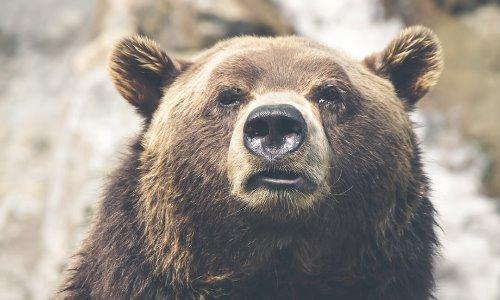The grizzly bear as commonly seen today is known to include any North American subspecies of the traditional brown bear such as the Kodiak bear, the Mexican grizzly bear, the California grizzly bear and the mainland grizzly. This trait has led to the North American brown bear frequently referred to as the grizzly bear primarily due to the fact that both the brown bear and the grizzly are categorized as one species existing on two separate continents. Given this fact the brown bears as they are found in North America, Europe and Asia are noted as one of the most diverse bear species in existence today.
That being said in some regions, the grizzly because of its silvery, grizzly shimmery coat has been adeptly named by some specialists as the silvertip bear.
Due to the widespread nature of the mainland grizzly bear the species has been accepted as a classic representative for the entire subspecific genus. Nonetheless, grouping of the various species of the grizzly is constantly reviewed respective to their genetic linage. Excluding cubs and females, grizzly bears on a whole are generally found to live a solitary, yet somewhat active life. However where they are found in costal areas, the grizzly bear will muster around ponds, streams, lakes and rivers to hunt for food especially during the the salmon run.
Facts about the Grizzly Bear
▪ The Female grizzly bear often referred to as the sow will produce one to four cubs often weighing no more than one pound every other year and will attack as a protective measure whenever she perceives the lives of her cubs may be threatened.
▪ Not to be confused with the word “grisly” meaning horrifyingly repellent, gruesome or terrifying, the word “grizzly” is taken as in its meaning of the term “grizzled” in recognition of the bears, golden and grey colored tips of its coat. Notwithstanding, an American ornithologist by the name of George Ord in 1815 after conducting a careful study of the species classified the California grizzly not according to its golden and grey colored coat but rather in recognition of its temperament for fighting longhorn bulls.
▪ A typical adult female grizzly bear will weigh anywhere between 290 to 440 pounds, while an adult male will often weigh a total of 400 to 790 pounds with both subspecies having a similar and average total length of six and a half feet and a comparative shoulder height of over three feet. Female grizzly bears however found within the Yukon River are seen as slightly smaller than average sow and are known for having a total weight of just over 200 pounds.
▪ North America recognizes a wide range of grizzly bears with a population extending from as far as the northwestern regions of Alaska south to Mexico and east to the western shores of the northeastern saltwater Hudson Bay, Canada. Today the species however is primarily found within North America, Alaska, Montana, Idaho, Wyoming, Washington and throughout most of Canada which observes over 25,000 grizzly bears in Yukon, British Columbia and Alberta as well as in the northwestern territories of Ontario, Manitoba and Nunavut.
▪ The state of Alaska today recognizes the highest population of grizzly bears across the globe with over 30,000 bears within the region and densest along the coastline according to the abundance of food supplies located there.
▪ There are an estimated 1,500 grizzly bears left within the lower 48 states of the United States, of which about 800 can be found in the state of Montana with the remaining grizzles of around 600 located in the state of Wyoming.
▪ The average lifespan of the male grizzly bear when calculated roughly stands at 22 years, while the female due to their less dangerous lifestyle are estimated as living slightly longer often at 26 years. Of note the oldest inland grizzly bear living in the wild was found to be 34 years old and living in the state of Alaska, and the oldest coastal bear ever found was 39 years old.
The North American Bear Center Grizzly Bear Webcam
The North American Bear Center in Ely Minnesota today is a non-profit foundation aimed not only to advance the long-term survival of bears worldwide, but also to replace any misconceptions about bears by introducing a number of scientific facts emphasizing their current role in ecosystems and their true relationship with humans.
Visitors to their online website are able to access a wealth of information about bears worldwide, in addition to viewing a number of live webcams and pre-recorded videos featuring the bears living in their natural habitat.
View The North American Bear Center Grizzly Bear Webcam.
Holly Bear’s Den Cam
The Holly Bear’s Den cam features the daily activities of North American Bear Center four Ambassador Bears known as Ted, Honey, Lucky and Holly.
View Holly Bear’s Den Cam.
National Park Service Grizzly Bear Webcams
The National Park and Reserve Alaska via its online website features a number of webcams offering a first hand view into the daily routine of a number of grizzly bears within the region.
View National Park Service Grizzly Bear Webcams.
Knight Inlet Lodge Webcam
Glendale Cove in Knight Inlet hosting one of the latest concentrations of brown grizzly bears within British Columbia, Canada today is a great place to watch the grizzly bears in their natural environment. Their online webcam features a live view overlooking the Knight Inlet Lodge shown in the link posted below.
View Knight Inlet Lodge Webcam.
Woodland Park Zoo Bear Cam
The Woodland Park Zoo Bear Cam at Seattle’s Woodland Park Zoo features a pair of 20 year old grizzly bears located in the award winning exhibit known as the Northern Trail.
The bears can be seen in the video actively fishing for trout, often collaborating together to round up and capture their food.
View Woodland Park Zoo Bear Cam.

